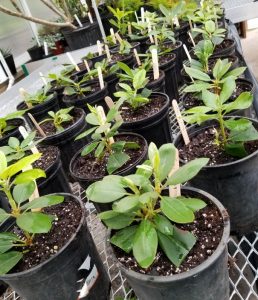The Rhododendron Study Team, which was formed six years ago at Laurelwood Arboretum, has a goal of preserving and protecting the rhododendron collection in the arboretum. Hundreds of rhododendrons were planted by John and Dorothy Knippenberg many years ago when the site was operated as a commercial nursery known as Laurelwood Gardens specializing in rhododendrons and azaleas.
Study team volunteers have identified and cataloged 403 rhododendrons and azaleas to date. These include 141 different named hybrids and 21 species. Detailed information on each plant has been entered into a plant collection management computerized database. An anodized aluminum alloy plant tag containing a unique accession number has been affixed to each plant.
Another goal of the study team was to locate the many missing Knippenberg hybrid rhododendrons that may be growing in private and public gardens and nurseries as well as rhododendrons that appeared on Dorothy Knippenberg’s early inventory list of rhododendrons growing in the arboretum, and return them to Laurelwood Arboretum.

For the first time in many years, new rhododendrons were added to the collection. We planted 77 named rhododendron hybrids in the arboretum last year. Many of these named hybrids were once growing in the arboretum during the Knippenbergs’ tenure. We were able to find and purchase selected hybrids from nurseries in Portland, Oregon and Hammonton, New Jersey. These nurseries had obtained rhododendron cuttings from Laurelwood Gardens—as was the case of Van Veen Nursery in Portland—or supplied rhododendrons and azaleas to Laurelwood Gardens as was the case of R. F. DeMarco Nursery in Hammonton for many decades. We also obtained mature rhododendrons that were donated by Dr. Al Fitzburgh of Caldwell and the Estate of Allan and Shirley Anderson of Franklin Lakes. Our Laurelwood staff and volunteers removed the rhododendrons from their respective gardens and planted them in the arboretum.
Another important goal was to establish a propagation program to raise rhododendrons and azaleas to replace or complement rare, older named hybrid rhododendrons and azaleas growing in the arboretum that are no longer available for purchase in commercial nurseries. Our inaugural efforts with the propagation of plant cuttings three years ago were successful. We propagated 58 cuttings taken from our ‘Laurelwood Sunset’ evergreen azalea “mother plant” and rooted them in our Educational Greenhouse. The young, potted plants were raised in the greenhouse until they were ready for outdoor storage and planting. Last year, we planted several of the new azaleas in the arboretum and sold approximately 35 of the azaleas at our annual plant sale fundraiser.
We took cuttings from several mature rhododendrons growing in the arboretum and local private gardens and rooted the cuttings in our Educational Greenhouse. We selected rhododendrons with a connection to the Knippenbergs, such as R. ‘Paul Vossberg’ which Dorothy Knippenberg propagated and named, as well as plants that have been growing in the arboretum for several decades. We have been raising the small plants in the greenhouse for the past two years and recently we repotted them. We plan to over-winter the plants in a cold frame this year.
We also purchased 28 rooted cuttings from Van Veen Nursery in Portland, Oregon, the same nursery that exchanged cuttings with the Knippenbergs decades ago, and we raised them in the Educational Greenhouse until they were mature enough last fall to plant outdoors. We planted 18 of the rhododendrons in the arboretum and sold ten R. ‘America’ at our plant sale.

For more information or questions regarding Laurelwood’s Rhododendron Study Team, contact Joe Di Giacomo at digiacomo617@optonline.net. It was the desire and vision of Dorothy Knippenberg that Laurelwood would become a public rhododendron park. Our efforts to preserve, protect and maintain the rhododendron collection reflects that vision.
By Joe Di Giacomo
